- Comics
- Comics Reviews
- Manga
- Comics Reviews
- European Comics
- News
- Comics News
- Press Releases
- Columns
- Spotlight
- Digital Comics
- Webcomics
- Cult Favorite
- Back Issues
- Webcomics
- Movies
- Toys
- Store
- More
- About
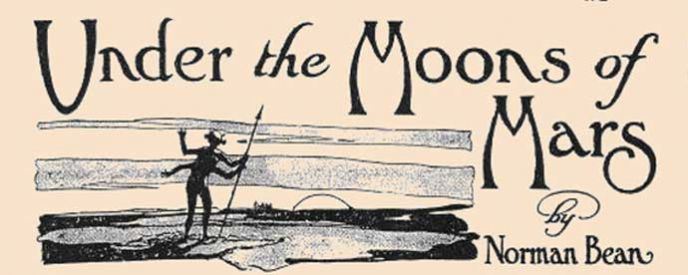
By Philip Schweier
September 16, 2014 - 18:34
With the release of the John Carter movie in
2012, I decided to revisit the Edgar Rice Burroughs books I read in my early
teens. I began with the first series I read, the Mars series. It’s also the
first series written by Burroughs, leading to the John Carter motion picture a
century later.

Edgar Rice Burroughs
It’s been said that the pivotal age for a science fiction fan is 13. It’s
usually at that age that our sensibilities for geekery are formed, usually
through exposure to a specific TV show or movie.
The John Carter books were my entry point into the world of science fiction. As
I hit my early teens, my older sister gave me a boxed set of the first four
Mars novels by Edgar Rice Burroughs. It is a common starting point for many
future sci-fi geeks; suitable as it sometimes represents the birth of modern
science fiction.
Today, 100 years after the first novel’s publication, many of Burroughs’ ideas
appear somewhat derivative, but in truth many of them predate virtually all
other science fiction. Like Flash Gordon, John Carter is the story of an
Earthman transported to a hostile alien world. Winning one battle after
another, he is able to unite the planet’s warring peoples under a single sword.
The stories feature beautiful alien princesses, extraterrestrial people and
evil despots.
Burroughs grew up in Chicago, and as a young man tried a variety of
careers, each one never truly succeeding. Out of desperation – or perhaps
depression – he turned to writing.
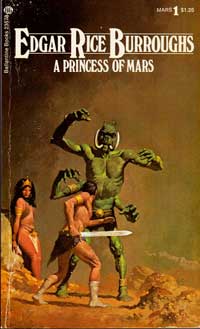
His first novel, published as Under the Moons of Mars, tells how John
Carter, a Virginia cavalryman, is transported to the dying world of Mars, known
as Barsoom by its inhabitants. There, he encounters a variety of races living
in constant conflict. He falls in love with Dejah Thoris, a princess of the
city of Helium, and by befriending Tars Tarkas, a leader among the green men,
he is able to unite the people of Mars. John Carter is happy to remain on Mars,
but a looming crisis threatens the dying planet, and he is returned to Earth.
Burroughs submitted to All-Story magazine in 1911 under the pen name
“Normal Bean,” fearing such a fantastic story would draw only ridicule, and
ruin him as a businessman. However, a typesetter error led to the story being
credit to “Norman Bean.” The story was a hit, garnering an immediate sequel and
republished in book form in 1917 as A Princess of Mars.
The second book, The Gods of Mars (1918), chronicles John Carter’s
return to the red planet. He arrives in the Valley of Dor, regarded by the
people of Barsoom as the afterlife. It is ruled by the Therns, who are believed
to be ascended beings. John Carter challenges their use of superstition to
dominate others. In fact, many of ERB’s adventure novels use the exploitation
of religious faith as a plot device.
John Carter is reunited with Tars Tarkas and Dejah Thoris, but once again the
book ends with the two of them separated, leading into the third book, The
Warlord of Mars (1919). It introduces yet more species of Martian people,
the yellow and the white races. Combined with the two earlier novels, the three
books represent a trilogy chronicling John Carter’s ascendancy to the position
of Warlord of Mars.
It could be argued the original Star Wars trilogy is structured in the same
way. Part one is more or less a stand-alone story, part two ends in a
cliffhanger, and part three resolves everything.
The next two books in the series shifts the focus from John Carter and Dejah
Thoris to their children, Carthoris and Tara.
In Thuvia, Maid of Mars (1920) Carthoris is accused of kidnapping the
princess Thuvia. He flees Helium to rescue her and thereby clear his name. The
Chessmen of Mars (1922), introduces the game of Jetan, a Barsoomian version
of chess played with living people. When Tara’s flier is sent off course in a
storm, she finds herself among the Kaldanes, a race of beings consisting of
oversized heads and spidery legs. The Kaldanes can attach themselves to
headless torsos called Rykors, living a symbiotic existence.
Subsequent books continue the trend of distancing themselves from
John Carter. The Master Mind of Mars (1928) introduces Ulysses Paxton, a
fellow Earthman also transported to Mars. There, he encounters a number of
peoples John Carter had yet to meet, including master surgeon Ras Thavas, who
has developed technique for transplanting the brain of one person into the body
of another. Paxton falls in love with a Barsoomian woman whose body now houses
the twisted brain of an aging queen, and he vows to restore her.
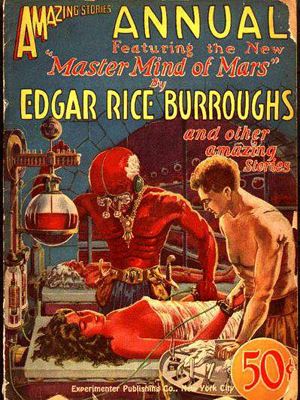
A Fighting Man of Mars (1931) features the story of Tan Hadron, a
low-ranking soldier in love with the haughty Sanoma Tora. When she is
kidnapped, he attempts to rescue her, and in the course of his adventures helps
a slave girl, Tavia, escape her captors. Eventually Tan Hadron realizes Tavia
is more deserving of his devotion than the shallow Sanoma Tora.
Swords of Mars (1935) featured the return of John Carter, and is for all
intents and purposes two stories. In the first half, John Carter leads a
clandestine war against Barsoom’s Guild of Assassins, in an effort to wipe the
vile practice from the face of Barsoom. However, when he discovers the
assassins have targeted his beloved Dejah Thoris for kidnapping, the story becomes
a rescue mission to Thuria, Barsoom’s lesser moon. Here, he of course
encounters more strange races before returning home to Helium.
John Carter continues to be the featured character in The Synthetic Men of
Mars (1940), though the book is told through the eyes of Vor Daj, a member
of his personal guard. The genius Ras Thavas returns – this time in a new body,
of course – as John Carter goes in search of him, that his master of surgery
may heal his Dejah Thoris. But first, John Carter and his companions must fight
their way through hormads, artificially created men who hope to conquer
Barsoom.
Llana of Gathol (1948) was the last of the Mars books, in a manner of
speaking. ERB died two years after the publication of this tale of John
Carter’s adventure with his granddaughter, the daughter of Tara. It is actually
four stories: "The Ancient Dead," "The Black Pirates of
Barsoom, "Escape on Mars," "Invisible Men of Mars,”
originally published in Amazing Stories seven years earlier.
The final book in the series, entitled John Carter of Mars is a weak
entry into what had been a rather entertaining adventure series. It is
comprised of two separate stories. The first, “John Carter and the Giant of
Mars,” has been attributed to ERB’s son John Coleman Burroughs, and had been
written for a Whitman Big Little Book in 1940. It is noticeably different from
all the other stories in that it is not told in the first person.
The second story, "Skeleton Men of Jupiter," was first published in Amazing
Stories in 1943. Like Llana of Gathol, the plan was to collect the
novelettes into a single book, but Burroughs died before subsequent stories could
be written. “Skeleton Men” tells the story of John Carter being kidnapped by
the warlike people of Jupiter who intend to invade and conquer Mars.
Apparently, ERB ran out of room on Barsoom for yet another race of
extraterrestrial challenges for his hero. The story – and the series – ends,
with John Carter and Dejah Thoris marooned on the planet Jupiter.
As with many of Burroughs’ stories, the Mars series features a strong element
of romance, as women are kidnapped and later rescued by the hero who is in love
with them – or may simply not know it. There are also common themes of science
gone awry, foreshadowing the ethical dilemmas of genetic engineering, as well
as excessive intellect resulting in a disassociation form humanity.
John Carter is credited for inspiring later science fiction adventures such as
Flash Gordon and Superman. However, it never met the enormous success of Burroughs’
Tarzan. An animated cartoon was planned in the 1940s but never realized.
In 1952, John Carter was featured in a handful of comic books
published by Dell. By the early 1970s, DC Comics had taken over the publication
rights for Tarzan comic books, and by extension John Carter in a back-up
series. It wasn’t until Marvel Comics took over the license in 1977 that he got
his own title. John Carter, Warlord of Mars ran for 28 issues and three
annuals. It featured dramatic art from the likes of master comic book
illustrators Dave Cockrum and Gil Kane. Today, Dynamite Entertainment has
published a series that for the most part adapts the original A Princess of
Mars. A number of affiliated series were also published featuring Dejah
Thoris before she met John Carter.
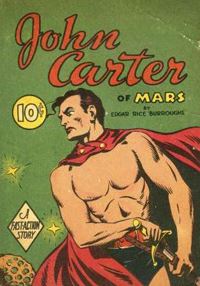
The John Carter character perhaps holds the record for the most time spent in
Hollywood’s “development hell.” Since as early as 1931, the character has been
in some form of development for film, most notably as an animated feature under
the direction of Bob Clampett. It wasn’t until The Asylum released A
Princess of Mars (2009) that John Carter made it to film. Starring Antonio
Sabato Jr. as John Carter and Traci Lords as Dejah Thoris, the low-budget movie
deviates heavily from Burroughs original story. It features Carter as a
military sniper transported to Barsoom in a government program.
However, a more faithful adaptation was released in March, 2012, by
the Walt Disney Company. Entitled John Carter, it starred Taylor Kitsch
as John Carter and Lynn Collins as Dejah Thoris. Directed by animation director
Andrew Stanton (Finding Nemo, WALL-E), the movie uses extensive computer
animation to depict the other-worldly environment of Barsoom.
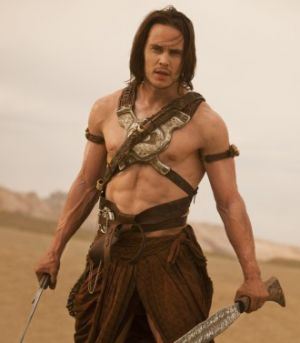
Rather than a strict attempt to adapt the original novel, the story uses A
Princess of Mars as a framework, shoring up some of ERB’s shortcomings as a
novice writer with a more modern approach to storytelling. Though the film was
well received by fans of the novels, the movie performed poorly at the box
office, perhaps due to a less-than-enthusiastic marketing campaign. A sequel is
listed on the Internet Movie Data Base, but it is unlikely to be produced.
Part 2: Pellucidar
Part 3:
Tarzan of the Apes